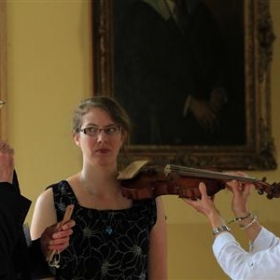SYMPOSIUM String Playing in Balance
Published on isbi School News dated Thursday 5th of September 2013
On Sunday 9 June, Oundle School hosted thirty delegates from countries including USA, Canada, New Zealand, Denmark, Holland and Ireland at an event designed to share ideas and practices developed in the School's String Department over the last three years.The Department has assembled a team of string teachers, Alexander Technique teachers and now a trained technician who work with external consultants Crissman Taylor (Utrecht Conservatoire and Violinist in Balance) and Peter Buckoke (Professor of Double Bass and Alexander Technique Royal College of Music, London). This year the project has also been assisted by Sarah Wood from the University of Colorado where she has just been awarded PhD for her study Principles of Chin Rest support and use: An analysis of commercial chin rests and Violinist in Balance jaw maps.
The day started with an introduction to the project by Oundle's Head of Strings, Angus Gibbon, who spoke about his personal experiences as a violinist and the benefits to his health and violin playing from changing his chin and collar bone rests with guidance from Crissman Taylor and his Alexander Technique teachers Sue Holladay and Jenny Walsh.
Crissman Taylor then explained her thinking on how best to support the violin and the fact that conventional equipment impairs freedom of movement and coordination. She illustrated the importance of placing the violin onto the collar bone and creating a wedge which is then placed under the violin connecting it to the skeleton. The primary benefit of this is that supporting the violin in this way stops the blockage of freedom of movement for both arms and in particular the right arm. She illustrated this effect by pairing up delegates who then examined the effect of placing weight on the left shoulder to the right arm and the benefit of then placing the weight closer to the collar bone and the increased freedom of the right arm as a consequence. She then talked about the construction of the chin rest that caters for the length of the neck and the shape of the jaw and her concept of a 'jaw sweep' which leaves a margin for freedom of movement for the violinist.
Oundle violin teacher, Tim Warburton who is now a trained fitter and maker of chin rests, under Crissman's supervision, then gave a talk about measuring violinists and making chin rests to fit individuals. He explored the possible positions for the violin and demonstrated that in order to achieve a freely moving straight bow what really matters is the position of the violin. There was then a demonstration of the fitting process where Alexander Technique teacher, Julia Cowper illustrated the importance of creating good playing position before proceeding to the measuring process.
The next session was dedicated to the Alexander Technique programme that has been developed at Oundle School specifically for the violinists and violists to adjust to the new equipment and in creating better body usage in general. Head of Alexander Technique, Jenny Walsh and Julia Cowper spoke about the programme of individual lessons and the workshops that they have developed to prepare and assist pupils to adjust to a new approach to playing. Sue Holladay, who initiated the whole project with Crissman Taylor whilst teaching Alexander Technique at Oundle School, spoke about the common postural habits of string players and how to change them.
The afternoon session started with a talk on issues affecting Cello and Double Bass playing. Peter Buckoke from the Royal College of Music worked with cellists James Wimpenny (17) and Hibiki Kono (16) and bass players Calvin Koo (16) and Nigel Smith (from Northampton Grammar School for Boys). He discussed the issue of instrument placement and how the position of the C peg on the cello created a problem positioning the instrument. He also addressed common habits of collapsing down into the cello. By gently encouraging a change of habits and repositioning the instrument it was immediately obvious to the listener that it was possible to create more quality and scope of tone. The same was true for the bass players. He worked on the two ways of playing the bass, standing or sitting and looked for solutions to do with stabilising the instrument without collapsing downwards.
Angus Gibbon then gave a talk about the impact of the work with new support equipment and the Alexander Technique programme on his violin teaching. He illustrated the ways that he works with his pupils to support the change of equipment and in creating awareness of the body movements involved in string playing. He showed how by working with two sticks, a violin and a bow stick, you can rehearse the new position of the violin without the old head habits being involved. He then illustrated, using the sticks, how to develop violin technique with reference to: contact points, bow weight, bow speed, bow strokes, playing on and off the string, developing the bow hold and other technical matters and issues to do with coordination.
The day concluded with the delegates joining the School's Senior String Ensemble in a performance of Bartok Rumanian Dances. All present were then invited to join a stretching and 'gorilla walking' routine led by Jenny Walsh. She has been working with the orchestras at Oundle to improve playing habits, sitting habits and concentration. There was a second performance of the Bartok with magnified life, musical and physical energy and improved quality of tone.
Angus Gibbon commented, 'This event was a real testament to the pioneering work that we are doing here at Oundle School.'








